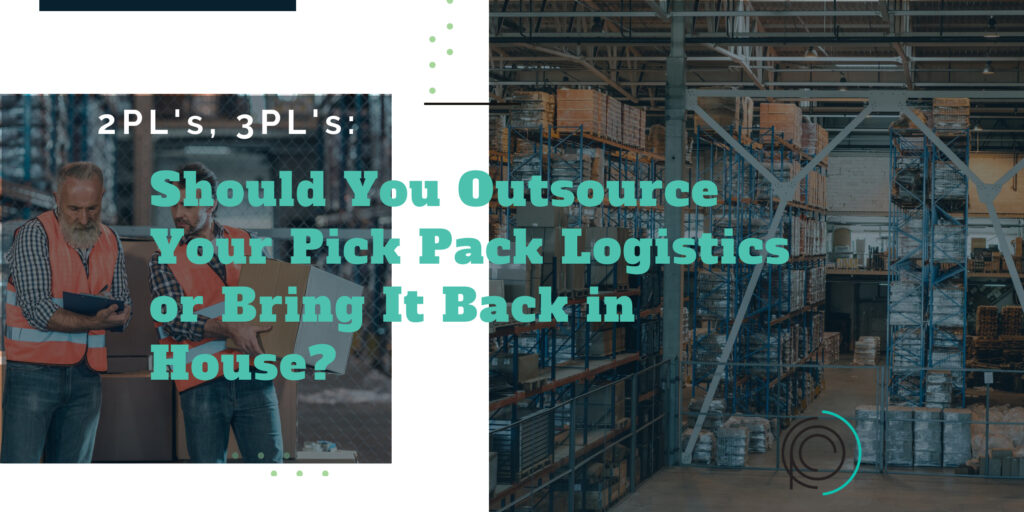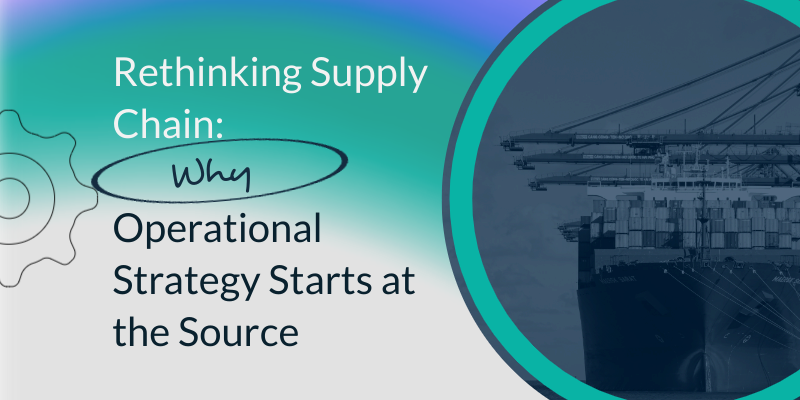The Great Logistics Debate: Outsourcing vs. In-House for Optimal Operations
Effectively navigating the decision between outsourcing pick pack operations to a third-party logistics (3PL) provider or maintaining an in-house approach is a pivotal decision point for businesses, and it necessitates a thorough examination of numerous factors. Each of these factors holds significant implications for the efficiency and overall success of your operations. To assist leaders in making an informed decision, we will explore the advantages and disadvantages associated with outsourcing your pick pack to a 3PL, versus managing your own 2PL logistics. The emphasis is placed on aligning these choices with the unique needs of your business, ensuring a comprehensive understanding of the implications involved.
Let’s dive into your choices.
Running Your Own 2PL
Establishing and managing your own 2PL can yield cost savings and provide you with complete oversight of your company’s operations. However, the venture demands a substantial initial investment and a solid plan to successfully set up and run such an operation. It is imperative to meticulously set up all facets of the operation to optimize storage space, ensure efficiency, adhere to regulatory compliance standards, and furnish the necessary equipment, supplies, and resources. Additionally, securing the right location, configuring internal processes, implementing appropriate technology, assembling an experienced team, establishing clear policies and procedures, and ensuring compliance with safety guidelines. This high-level list is not meant to deter you from embarking on the challenge, it is, however, what you will need to set up your warehouse successfully.
You can eliminate or minimize some of the common challenges companies face when outsourcing their pick pack logistics such as losing pallets of inventory, misshipments, reverse logistics, last mile reporting and logistics, claims, and damages. You will oversee managing vendor relationships, negotiating fees, and tracking. Customer service teams will also need to manage customer concerns and have the tools to rectify customer issues.
Despite these challenges, operating your own 2PL provides unparalleled control over every aspect of your business. This encompasses authority over carriers, pricing strategies, kitting processes, operational hours, and inventory management. Essentially you can run the logistics of your business to align with your goals and brand.
Advantages:
- Total Control: By having complete control over your pick pack operations, you gain the ability to tailor your logistics processes to precisely fit your business’s unique requirements. This level of customization allows for an immediate response to the ever-changing needs of your business landscape, giving you the flexibility to decide not only how operations are conducted but also the extent and scale at which they are implemented.
- Direct Oversight: Operating your own logistics allows for direct oversight of your team, processes, and inventory. This fosters a hands-on approach, enabling you to manage all facets of your logistics more effectively. Such oversight ensures that operations align with your business objectives, enhancing efficiency and productivity.
- Costs: A key advantage of managing your own second-party logistics (2PL) is the ability to control and maintain costs more effectively. By operating in-house, you avoid the markups that third-party logistics providers (3PLs) typically charge for their services. This direct management of expenses can lead to significant cost savings and more budget-friendly operations.
Disadvantages:
- Resource Intensity: Establishing and sustaining an in-house logistics operation requires substantial upfront investments. This includes the need for infrastructure, cutting-edge technology, and the recruitment of skilled personnel. The initial and ongoing investment in these resources can be considerable, demanding a strong commitment and financial planning.
- Limited Scalability: While in-house operations offer control and cost benefits, they may also face significant challenges in scaling up or down efficiently. This is particularly true in response to sudden fluctuations in market demand. The inherent rigidity of managing logistics internally can limit a business’s ability to respond agilely to the market’s ups and downs, potentially leading to inefficiencies.
- Human Capital Limitations: The success of in-house logistics heavily relies on the quality of the workforce. However, hiring and retaining the right talent is an ongoing challenge, especially in a competitive job market. Finding individuals with the necessary skills, experience, and fit for the company culture requires substantial effort and resources, and managing a high-performing logistics team demands continuous leadership and development initiatives.
Outsourcing Your Pick Pack Logistics to a 3PL
Outsourcing your pick-pack logistics to a third-party logistics provider (3PL) offers a key advantage: the capacity to scale your business while entrusting the intricacies of pick-pack logistics to professionals. This eliminates the need for a specialized in-house team, allowing your recruitment efforts to be directed toward other essential skill sets. Delegating this operational aspect to a third party affords you the opportunity to redirect resources to critical areas of your business, such as sales and marketing. Moreover, you sidestep the overhead costs associated with maintaining your own warehouse, including insurance, human capital insurance, and the need for a comprehensive continuity plan.
However, it’s essential to acknowledge the trade-off. You will need to align your policies with the lead-time, reverse logistics, returns, and damages policies of the vendor handling your logistics.
Depending on a 3PL involves relinquishing control over your operations, reputation, and inventory. Adherence to the 3PL’s rules, regulations, and policies becomes necessary, and their services come at a cost that must be factored into your financial considerations. You will need to decide on whether you can and will pass some of those costs off to your customer such as shipping and return charges or build these costs into your price.
Advantages:
- Scalability: Third-party logistics providers (3PLs) offer scalable solutions that are a major asset for businesses looking to adjust seamlessly to market demands. This flexibility allows your business to grow or scale back operations without the burden of making significant internal adjustments or investments, accommodating fluctuations in demand with ease.
- Cost Efficiency: Leveraging the specialized resources of a 3PL can lead to substantial savings in operational costs. These providers have the infrastructure, staffing, and technology specifically designed for logistics, meaning you can reduce or eliminate the expenses associated with these areas in your own business. This can make your operations leaner and more financially efficient.
- Expertise: 3PLs bring a wealth of knowledge and experience in logistics management, including the critical area of pick-pack logistics. They stay on top of industry best practices, regulatory changes, and innovations, ensuring that your logistics operations benefit from the latest insights and technologies. This expertise can enhance your supply chain efficiency and effectiveness.
Disadvantages:
- Loss of Control: One of the trade-offs of using a 3PL is the relinquishment of direct control over some aspects of your business operations. This includes the handling and management of inventory, as well as the execution of specific logistics and fulfillment procedures. For some businesses, this can raise concerns about the consistency and quality of service delivery according to their standards.
- Dependency: When you entrust a significant portion of your operations to a 3PL, your business becomes inherently dependent on their performance and reliability. Any disruptions in their service, whether due to operational challenges, technological issues, or other factors, can have a direct impact on your business continuity and customer satisfaction.
- Fees: Engaging with a 3PL for pick pack logistics and other services introduces a transactional cost structure—you will incur fees for each action performed, such as each item picked, plus additional charges for kitting projects, inserts, reverse logistics, and storage. These costs can add up, and it’s important to carefully manage and monitor these expenses to ensure they align with your business objectives and budget.
The Balancing Act
Every business is made up of four essential components: people, processes, technology, and customer experience. To navigate the complexity of organizational strategy, each business must embark on a journey of self-discovery, meticulously understanding its unique needs, challenges, and operational preferences. Before deciding whether to embrace outsourcing or expand internal operations, a thorough examination of these internal dynamics is imperative.
It is essential for businesses to introspect and define their operational intricacies, discerning the interplay between their workforce, established processes, technological infrastructure, and the overall customer experience. This introspective analysis forms a starting point for strategic decision-making regarding the allocation of resources and the structuring of operational frameworks.
Amidst the dynamic landscape of business competition, it is prudent to resist the temptation of mirroring competitors without a comprehensive understanding of one’s own organizational fingerprint. While it is crucial to be aware of industry trends and benchmarks, blindly emulating the strategies of others can lead to misalignment with the inherent strengths and weaknesses of a specific business.
The decision-making process regarding whether to internalize operations or opt for outsourcing should be a product of the internal analysis. This analysis should delve into the specific needs, risk tolerance, and overarching goals of the business in question. By aligning the decision with internal requirements and strategic objectives, a business ensures that its chosen path is a tailored fit, fostering long-term sustainability and success. In essence, the choice between internalization and outsourcing should be an organic outcome of a thorough self-assessment rather than a reactionary response to external circumstances.
The Pros and Cons of 2PL vs. 3PL Strategies
Navigating the choice between 2PL (second-party logistics) and 3PL (third-party logistics) strategies involves a nuanced exploration of their respective pros and cons. Contrary to a straightforward decision, the considerations are multifaceted and demand careful examination. The following provides a comprehensive overview of the advantages and disadvantages inherent in both 2PL and 3PL strategies, shedding light on the complexities of this pivotal decision. Most importantly, this list will vary from one company to another, and it is important to fully understand the pros and cons of both choices.
Key Factors to Consider When Choosing a Strategy:
In summary, the choice between outsourcing pick pack operations and managing them in-house is a nuanced decision, and its success pivots on aligning the chosen strategy with the specific size and needs of your business. Deliberate consideration of the outlined advantages and disadvantages empowers you to make a well-informed decision, steering your business toward optimal operational efficiency and sustainable growth.
When formulating a strategy for pick-pack operations, the dimensions of your business—its size, budget, and unique requirements—must be central to the decision-making process. Smaller enterprises might find value in internalizing pick-pack logistics, whereas larger businesses, grappling with extensive operations, could benefit from the scalability offered by third-party logistics services. Considerations should also encompass your capacity for regulatory compliance, customization needs, and shipping requirements.
The choice between a 2PL and a 3PL strategy emerges as a pivotal business decision, demanding a meticulous evaluation of your current business standing and long-term aspirations. While each strategy carries inherent advantages and drawbacks, a nuanced understanding of your business’s distinctive needs becomes instrumental in selecting the solution that fosters sustained growth. Seeking counsel from logistics experts can be invaluable in guiding your decision-making process, ensuring that the chosen strategy aligns seamlessly with your business objectives. Speak with a logistics expert today about your logistics needs.







